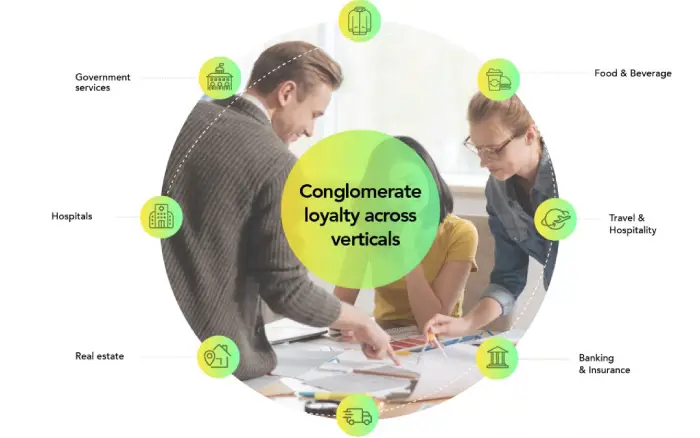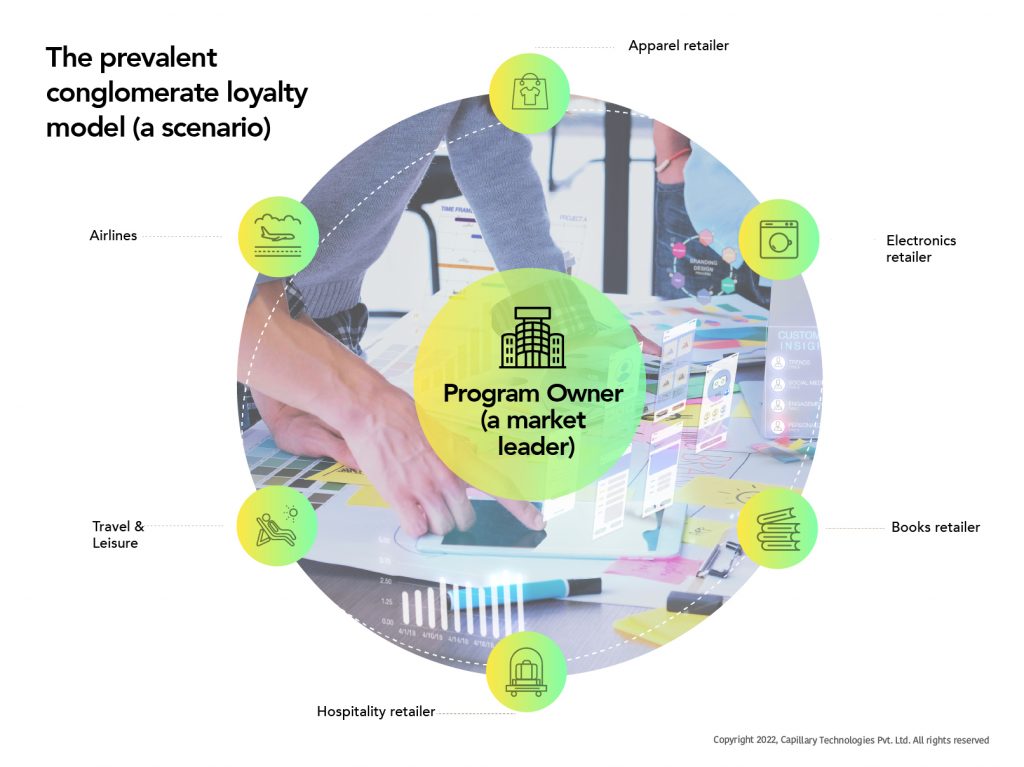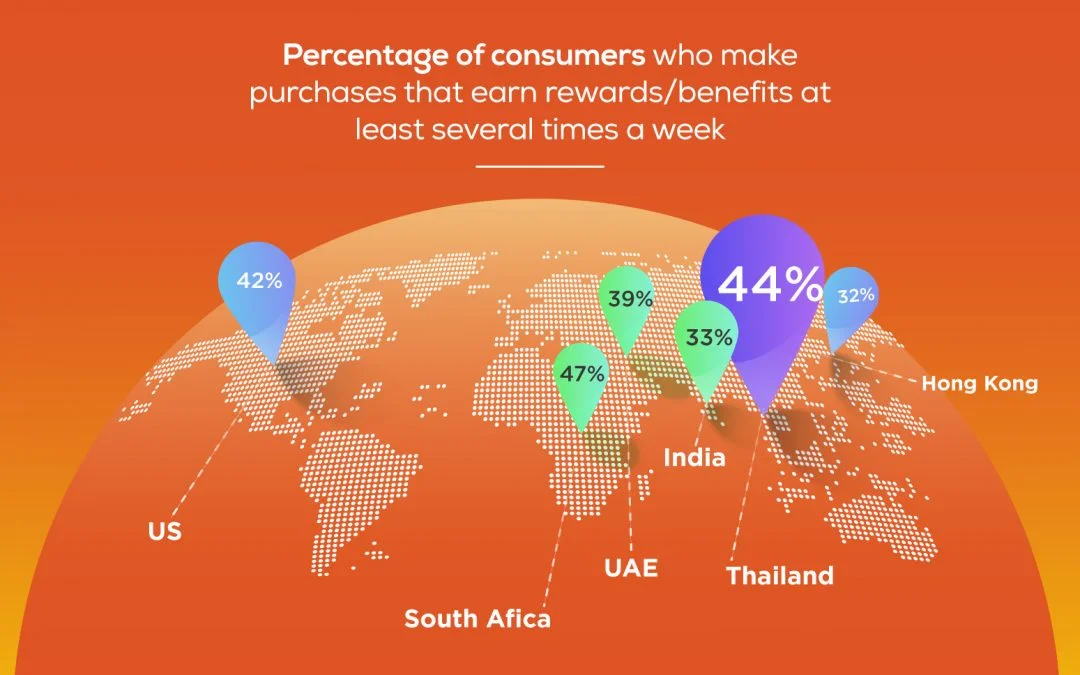- Design industry shaping loyalty programs
- Integrate easily and go live quicker
- Deliver hyper-personalized consumer experiences
Blue Rewards from Al Futtaim Group Shares Loyalty Success Stories and Evolution. Watch Podcast >
Capillary Triumphs with 4 Prestigious Wins at the 2025 International Loyalty Awards! Read more >

Today’s consumers seamlessly switch between devices, channels, and brand ecosystems and loyalty programs are naturally expected to keep up with this dynamic. Traditional single-brand approaches often fall short in this environment. That’s where a multi-brand loyalty program becomes essential, especially for conglomerates aiming to build unified yet flexible engagement models across diverse business units.
Often referred to as conglomerate loyalty, multi-brand loyalty encompasses frameworks where related or non-competing brands collaborate to create richer, cross-brand experiences. A key variant of this is coalition loyalty, where independent brands join forces to deliver shared rewards and value. In fact, recent industry data highlights the rising momentum behind coalition programs, as consumers increasingly favor loyalty ecosystems that let them earn and redeem across a variety of brands.
In this blog, we’ll explore how organizations can structure a scalable and customer-centric multi-brand loyalty program, backed by trends, technologies, and best practices. We’ll also help you evaluate whether a coalition-style or standalone loyalty strategy best fits your growth ambitions.
With the availability of advanced technology, pooling information has become easier and designing large-scale multi-brand loyalty systems has become more achievable. A multi-brand loyalty program is a sophisticated pact between brands, especially within a conglomerate loyalty structure, and it must be efficiently handled to avoid potential deal breakers.
There have been numerous instances globally where well-known multi-brand loyalty programs were both forged and dissolved with each case offering insights into the complexities of partnership dynamics. These examples form the pillars for designing robust, scalable conglomerate loyalty programs. Below are three key models most commonly adopted when facilitating multi-brand loyalty campaigns:
In this model, a third-party marketing company owns the technology and drives the campaign. The third party acts as the program owner, while participating brands operate as tenants. In recent times, this coalition-style model has seen a decline in popularity due to drawbacks such as dependency on a middleman, making it less agile for modern multi-brand loyalty program demands.
Here, a single large brand takes ownership of the program, and other brands participate as tenants. This structure is currently popular and considered more effective, especially for conglomerates, due to the elimination of intermediaries and increased control over the multi-brand loyalty experience.
This emerging model uses a decentralized SaaS-based platform where participating brands collectively own and operate the system. It reduces manual intervention and offers greater autonomy to each brand. While still in its early stages, this model holds promise for future multi-brand loyalty programs, particularly those aiming to support decentralized or modular conglomerate loyalty strategies.

The intent behind bringing multiple brands together under a single multi-brand loyalty program must be precise and aligned. Common interests and strategic synergies are crucial for brands within a conglomerate loyalty setup. High-value or marquee brands may be assigned lower program costs, given their potential to draw in more consumers. This step demands significant strategic alignment and mutual value creation.
Selecting the right loyalty engine is critical for the success of any multi-brand loyalty program. It must support scale, flexible onboarding or removal of partner brands (tenants), and robust backend integrations. Features like real-time enrollment and customer identification are essential to ensure seamless experiences across brands.
For smooth operations, the multi-brand loyalty ecosystem must have a clearly defined approval chain. The program owner should ideally have decision-making authority to maintain alignment across the conglomerate, especially during campaigns, data sharing, or benefit distribution.
Partner brands should span complementary verticals to drive synergy without overlapping offerings. Within a conglomerate loyalty structure, this diversity reduces cannibalization and creates shared value. If brands operate in similar verticals, differentiated strategies must be deployed to maintain harmony and customer relevance.
Before launching the full-scale multi-brand loyalty program, start with a small pilot involving a few key brands. Once proven successful, expand steadily with a clear growth strategy. Adding brands without strategic alignment can undermine the entire loyalty framework.
A key advantage of a conglomerate loyalty or coalition loyalty program is data aggregation. Shared customer data across brands enables personalized campaigns and reveals valuable cross-brand purchase patterns, enriching the overall customer journey.
In a large multi-brand loyalty program, individual brands may want to run localized campaigns or upload unique data assets. A seamless data management framework that supports secure uploads, segmentation, and reporting is critical for operational efficiency.
Make point accumulation and redemption logical and rewarding. For instance, buying a mobile phone and redeeming points on accessories within the same ecosystem enhances satisfaction. Purpose-driven incentives in a multi-brand loyalty program foster emotional connections beyond basic discounts.
Capillary’s deep expertise in multi-brand loyalty programs has enabled some of the world’s most prominent conglomerates to elevate their customer engagement strategies. With data-led decision-making and powerful loyalty technology, Capillary’s experts have helped brands craft scalable, omnichannel conglomerate loyalty ecosystems. Empowered by Loyalty+, conglomerates have seen increased enrollments, stronger customer retention, and improved redemption outcomes.
Here are two standout examples:
Al-Futtaim Group, a UAE-based conglomerate, operates across key industries such as automotive, retail, real estate, and finance. Its multi-brand loyalty program, Blue Rewards, delivers a seamless experience via a mobile app that lets members track points, cashback offers, and brand-specific promotions. Powered by Capillary’s Loyalty+ platform, the Blue Loyalty app has seen thousands of downloads and a notable uplift in redemption rates, reinforcing the value of a unified conglomerate loyalty system.
Vietnam Investments Group (VIG) is a private equity firm supporting diverse sectors including manufacturing, transportation, tourism, education, retail, technology, and financial services. Their Tap Tap mobile loyalty app is a fully integrated multi-brand loyalty program that allows members to earn and redeem points across 600+ stores and e-commerce sites. Unifying 32+ brands in food, beverage, and entertainment, Tap Tap provides a seamless conglomerate loyalty experience that is both omnichannel and customer-centric.
If you’re considering building a multi-brand loyalty program, keep in mind that the steps mentioned above must be tailored to your brand’s specific goals, customer base, and market strategy. There is no one-size-fits-all model, every conglomerate loyalty initiative must reflect shared values and a cohesive vision.
One of the best-known examples of cooperative loyalty success lies in the airline industry. Programs like Star Alliance, SkyTeam, and Oneworld have proven the value of coordinated loyalty experiences, letting customers earn and redeem points seamlessly across multiple airline brands.
While earlier programs occasionally struggled due to challenges like geographical dispersion—forcing customers to travel just to redeem points—modern strategies have evolved. Today, brands are actively exploring co-location opportunities and building conglomerate loyalty ecosystems under unified digital umbrellas. Retailers now understand the value of shared infrastructure, streamlined rewards, and cross-brand customer engagement.
Ready to unlock similar success for your business? Connect with our team of experts to build a loyalty framework that scales with your ambitions.

May 5, 2025 | 4 Min Read
Create a scalable multi-brand loyalty program that strengthe

December 8, 2024 | 4 Min Read
Thailand's e-commerce market is booming and projected to gro

February 22, 2018 | 4 Min Read
Nowadays, brand loyalty amongst customers is on the decline